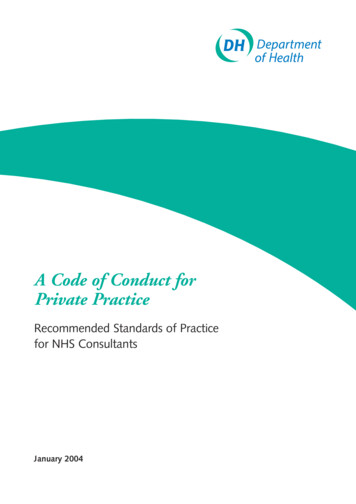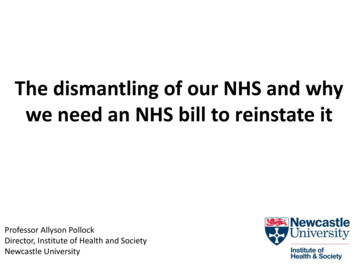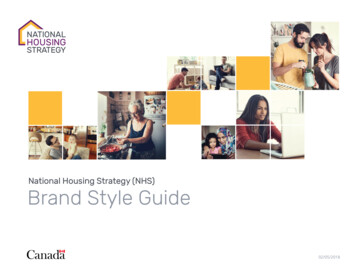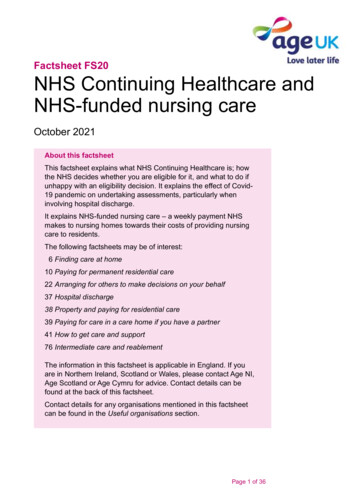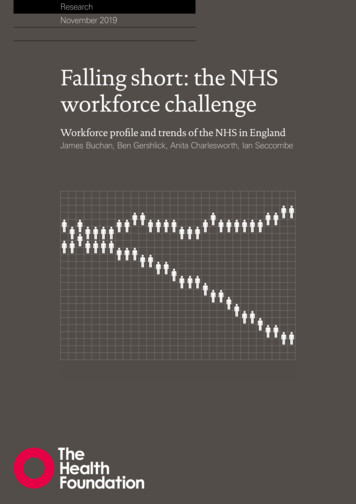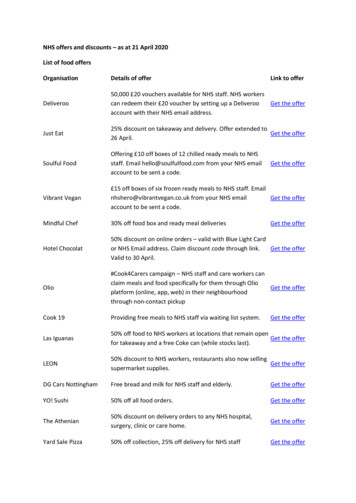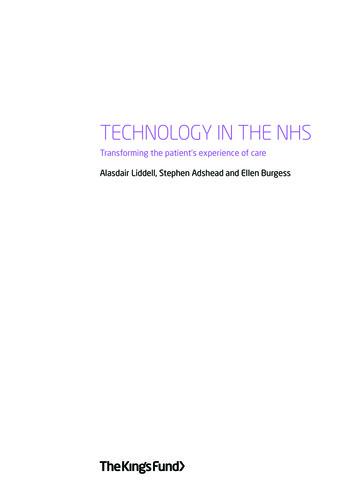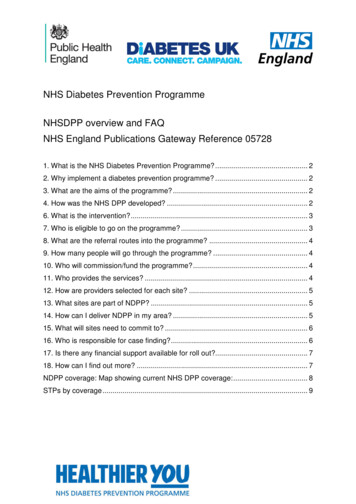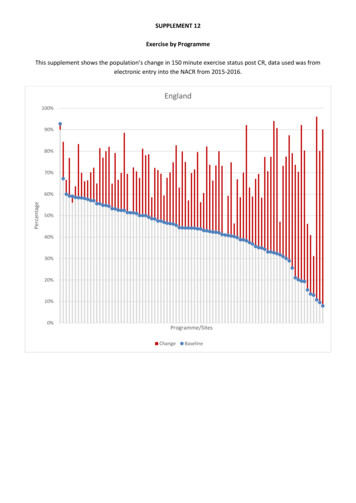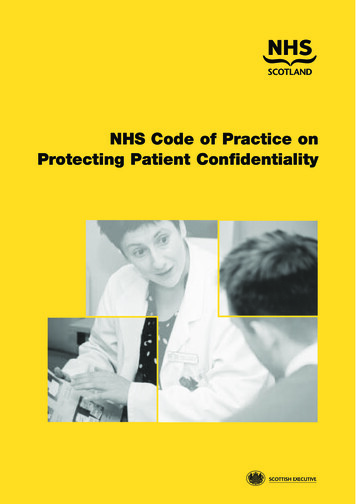
Transcription
NHS Code of Practice onProtecting Patient Confidentiality
1INTRODUCTION1.1 Accurate and secure personal health information is anessential part of patient health care. NHSScotland’s goal is fora service that: protects the confidentiality of patient information; commands the support and confidence of public,patients and all staff, students, volunteers and contractorsworking in or with NHSScotland; complies with best practice; conforms with the law; promotes patient care, the running of care organisations,and the improvement of health and care through newknowledge; and works in partnership with other organisations and hasclearly established and communicated protocols forsharing information.1.2 The use of information about patients is governed by: statute law, e.g. the Data Protection Act 1998, the HumanRights Act 1998, the Infectious Disease (Notification) Act1889, Adults with Incapacity (Scotland) Act 2000, theAbortion Act 1967, and many others; the common law in Scotland on privacy and confidentiality(which requires either consent or a legal or public interestrequirement for disclosure); professional standards; and the policies and organisational standards of the ScottishExecutive Health Department (SEHD) and NHSScotland,underpinned by the CSAGS report.**CSAGS report – Confidentiality and Security Advisory Group for Scotland, 2002
All personal health information is held under strict legaland ethical obligations of confidentiality. Information givenin confidence should not be used or disclosed in a formthat might identify a patient without his or her consent.There are a number of important exceptions to this rulewhich are described later, but patients should be involvedin decisions about use of their personal health informationin most circumstances.WHAT IS PATIENT IDENTIFIABLE INFORMATION? the patient’s name; the patient’s address; the patient’s full postcode; the patient’s date of birth; a picture, photograph, video, audio-tape or other imagesof the patient; anything else that may be used to identify a patientdirectly or indirectly. For example, rare diseases, drugtreatments or statistical analyses which have very smallnumbers within a small population may allow individualsto be identified; and the CHI (Community Health Index) number contains thepatient’s date of birth and a number to indicate their sex,so it should only be disclosed for health care purposesoutside the NHS if the patient has been informed andagrees.A combination of items increases the chance of patientidentification.
2REQUIREMENTS OF THE DATA PROTECTION ACT19982.1 The Act provides a framework that governs theprocessing of information which identifies living individuals.Processing includes obtaining, recording, holding, using anddisclosing information. The Act applies to all forms of recordsincluding paper, electronic and other images. It requiresorganisations to process fairly and lawfully any informationwhich might enable a patient to be identified.2.2 Patients need to be informed of the identity of the ‘datacontroller’ and the purposes to which their data will be put.The data controller is the organisation that determines how,and for what purposes, information from patients is collected.It might be a primary care practice or an NHS Board.Responsibility for complying with the 1998 Act rests with eachorganisation as a whole, with chief executives or primary carepractitioners bearing the ultimate responsibility for the actionsof their staff.2.3 The Act requires organisations to use the MINIMUMamount of information on a ‘need to know’ basis and to retainit only for as long as is needed for the purpose for which itwas originally collected. Guidance on the retention periodsfor health records has been issued by SEHD. Seewww.show.scot.nhs.uk/confidentiality.2.4 The Act also applies to partner organisations such asLocal Authority Social Work Departments, housing providers,etc.2.5 Practical guidance on the application of the Act andother relevant legal and professional guidance can be found atwww.show.scot.nhs.uk/confidentiality.
3POLICIES AND ORGANISATIONAL STANDARDSFOR NHSSCOTLAND3.1 The SEHD aims to ensure that personal healthinformation is kept confidential; and that patients are informedand involved in decisions about the use of their information.3.2 The Caldicott Framework was set up in March 1999. TheFramework requires each NHSScotland organisation to appointa senior clinician such as the medical director as ‘Caldicott orInformation Guardian’. The Guardian’s responsibilities include: auditing current practice and procedures; managing an improvement plan which is monitored throughthe clinical and corporate governance frameworks; developing protocols for inter-agency information sharingat a local level; and making decisions about how their organisation uses patientidentifying information. For example they provide advicein relation to research studies, or disclosure in the publicinterest.3.3 Each NHS Board has appointed a Data ProtectionOfficer, from whom staff can seek advice on all aspects of dataprotection and confidentiality. Local Authorities also have DataProtection Officers.3.4 It is policy that all NHSScotland employees, students,volunteers and contractors must be aware of, and respect, apatient’s right to confidentiality. All employees, students,volunteers and contractors must comply with this NHSScotlandCode of Practice on Protecting Patient Confidentiality. Failureto comply with the Code of Practice is a disciplinary offence.All must be aware where to seek support, further informationand training, and be able to demonstrate that they are makingevery reasonable effort to comply with the relevant standards.
4PROTECTING PATIENT INFORMATION4.1 Record patient information accurately.4.2 Keep patient information physically secure.4.3 Follow guidance before disclosing any patientinformation, e.g. using established information sharingprotocols.4.4 Ensure that best practice is followed for confidentiality inrespect of access to all patient information in any form, e.g.paper records, electronic data, emails, faxes, surface mail,conversations which can be overheard or phone calls.See www.show.scot.nhs.uk/confidentiality.4.5 Anonymise information where possible. See paragraph 8.
5PROVIDING INFORMATION FOR PATIENTS5.1 Patients must be informed about the need to discloseinformation in order to provide high quality care, e.g. betweenmembers of care teams and between different organisationsfor their direct health care; and other (possibly less obvious)ways that NHSScotland uses their information for suchessential components of healthcare provision as planning,statistics, payment, clinical governance, clinical and financialaudits.5.2 Patients should also be informed about other uses, whichprovide benefits to society, e.g. health surveillance, diseaseregistries, medical research, education and training. As far aspossible information should be anonymised. Where uses arenot directly associated with the health care that patientsreceive, staff cannot assume that patients who seek health careare content for their information to be used in these ways. Staffmust consider whether patients would be surprised to learnthat their information was being used in a particular way – if so,then patients are not being informed effectively.5.3 Patients can be given information in a range of waysincluding leaflets, talking with them, etc., ensuring that anyspecial language or other requirements are met appropriately.5.4 In order to inform patients effectively, staff should: check that patients have received appropriateinformation. Suitable leaflets should be available withineach NHS organisation; make clear to patients when information is recorded orhealth records are accessed; make clear to patients when staff are or will be disclosinginformation to others (who should be specified); check that patients are informed of the choices available
to them in respect of how their information may be usedor disclosed; and the possible consequences of theirdecision; check that patients have no concerns or queries abouthow their information is used or disclosed; answer any queries personally or direct the patient toothers who can answer their questions or provide othersources of information; and give information about and facilitate the right of patientsto have access to their health records.
6PROVIDING CHOICE TO PATIENTS ABOUT USEOF THEIR INFORMATION6.1 Patients have different needs and values – this must bereflected in the way they are treated, including the handling oftheir personal information. What is very sensitive or importantto one person in his or her particular circumstances may becasually discussed in public by another.6.2 Staff must: obtain patient’s informed consent before using theirpersonal information in ways that do not directlycontribute to, or support the delivery and planning of,their health care; respect and record patients’ decisions to agree to orrestrict the disclosure or use of information, whereverpossible; and inform patients if this is not possible; and communicate effectively with patients to ensure theyunderstand what the implications may be if they chooseto agree to, or restrict, the disclosure of their information.For example, clinicians cannot treat patients safely, norprovide continuity of care, without having relevantinformation about a patient’s condition and medicalhistory; complete records need to be kept of all careprovided so that neither patient safety, nor clinicalresponsibility for health care provision is neglected; itmay be more difficult to contact patients later if a newtreatment (or hazard) is discovered but their details arenot on the relevant database.
7OBTAINING CONSENT FROM PATIENTS ABOUTUSE OF THEIR INFORMATION7.1 Staff must ensure that as far as possible information isonly disclosed with the patient’s consent. To be valid, thatconsent should be informed and freely given. Consent may beverbal or written. Patients can change their choice aboutconsent at any time.7.2 Consent can be either implied (when a patient, havingbeen given information about a disclosure, and opportunity toexpress an objection, accepts a service without voicing anobjection) or explicit (when a patient actively expressesconsent). It must always follow effective involvement ofpatients.7.3 Explicit consent is best practice and should become thenorm as better informed patients share in decisions about theuses of their information.7.4 Always consider anonymisation if possible. If data areanonymised, it is good practice to inform the patient butconsent is not needed. See paragraph 8.7.5 Requirements for consent should be considered againsteach of the following criteria (for further information seewww.show.scot.nhs.uk/confidentiality): Legal Requirement. In some circumstances, the lawrequires clinicians to disclose information irrespective ofthe views of a patient, e.g. if patients contract certainnotifiable diseases. The Data Protection Act requires thatthe patient be told about the disclosure. To protect patients’ vital interests, e.g. where a child orvulnerable adult may be in need of protection, at risk ofdeath or serious harm. Professionals who have suchconcerns should draw them to the attention of therelevant authorities.
In the interest of the public. Examples might be theproduction of statistics (where the individual is notidentified) to assist in the planning of public services; orthe disclosure of information to the police to help in theprevention or detection of a serious crime. The DataProtection Act and professional standards specificallyallow for information to be disclosed in this way. Children and adults who are unable to consent. Therewill always be situations where a patient is unable to giveconsent, e.g. some children, adults with incapacity, andthe critically ill. In many of these cases, particularly in thecase of children, there will be someone, e.g. a parent,who is legally entitled to give consent on their behalf.7.6 There will be occasions when staff are asked to discloseinformation without consent, e.g. in relation to child protectionor suspected serious crime. The clinician-in-charge must beprepared to balance the considerations for and againstdisclosure in the interests of the patient and any third party;justify and record each decision to disclose or withhold. It willtherefore be a matter for the clinician’s best judgement aswell as legal and professional guidance. Decisions should betaken on a case-by-case basis in the light of best availableinformation, which may include advice from the Data ProtectionOfficer or Caldicott or Information Guardian. Wherever possiblethe patient should be informed what information has beendisclosed and to whom.7.7 Patients need to be informed of any possible implicationsfor their own care and the potential effect on others from adecision to withhold their data.
8ANONYMISATION8.1 Data are said to be anonymised when items such asname, address, full postcode, date of birth and any other detailthat might identify a patient are removed; the data about apatient cannot be identified by the recipient of the information;and the theoretical probability of the patient’s identity beingdiscovered is extremely small.8.2 Always consider anonymisation of data where possible.8.3 While the Data Protection Act does not restrict the use ofdata that do not identify patients, patients do have a right toknow when it is intended that their information will beanonymised for a range of appropriate purposes.8.4 An anonymising service is being developed within ISD* toanonymise all national returns. NHS Boards must set upsystems to ensure local data flows meet agreed nationalstandards which are being developed with ISD.**ISD – Information and Statistics Division of the Common Services Agency,NHSScotland.
9OBLIGATIONS ON INDIVIDUALS WORKING IN, ORWITH, NHSSCOTLAND9.1 All staff, students, volunteers, and contractors mustendeavour to meet the standards outlined in this code, as wellas their terms of employment (or other engagementagreements). These requirements build on existing bestpractice. Everyone should seek to ensure that protection ofpatient confidentiality is built into all health care.9.2 Staff, students, volunteers, and contractors may beconstrained from meeting these standards where appropriateorganisational systems and processes are not yet in place. Inthese circumstances the test must be whether they areworking within the spirit of this code of practice and aremaking every reasonable effort to comply.9.3 The need for change may apply to many existing systemsand processes and it is the duty of staff to inform the Caldicottor Information Guardian of any specific problems in relation toconfidentiality that are noted.9.4 Staff working in partnership with other organisationsshould ensure that they are fully aware of the informationsharing protocol(s) in operation.9.5 Specific legal restrictions apply to disclosure aboutSexually Transmitted Diseases (including HIV and AIDS) andHuman Fertilisation and Embryology Units. Staff working inthese areas need to be aware of these restrictions.
10PATIENTS’ RIGHTS OF ACCESS TO THEIRPERSONAL HEALTH RECORDS10.1 Patients (or their parents or legally appointedrepresentative) have the right to see and get a copy ofpersonal health information held about them, provided (in thecase of a child) they understand what this means. There maybe a charge for this.10.2 Staff should facilitate the patient’s right of access. Rareexceptions include occasions where the clinician-in-chargedocuments that access to the record could cause seriousharm to the patient’s or someone else’s physical or mentalhealth; could identify someone else; or is subject to legalrestrictions.10.3 If an access request means disclosing information from,or about, a Third Party (someone other than the patient orstaff involved in their care), the request may be refused unlessThird Party information can be temporarily removed, or theThird Party consents to disclosure or ‘it is reasonable in allthe circumstances’ to comply with the request without theconsent of the individual.10.4 Information needs to be provided within 40 days of arequest so staff must action requests promptly.If in doubt, staff should seek the advice of the local DataProtection Officer or d July 2003
I SBN0- 7559- 0875- 9 Crown copyright 2003Astron B312679 780755 908752w w w . s c o t l a n d . g o v . u k
4 PROTECTING PATIENT INFORMATION 4.1 Record patient information accurately. 4.2 Keep patient information physically secure. 4.3 Follow guidance before disclosing any patient information, e.g. using established information sharing protocols. 4.4 Ensure that best practice is followed for confidentiality in respect of access to all patient information in any form, e.g.
